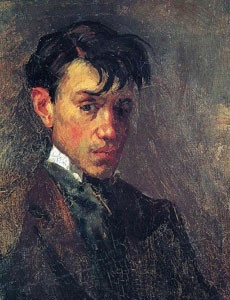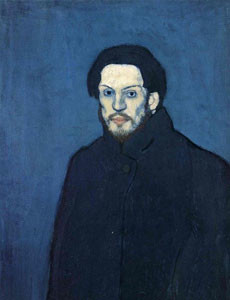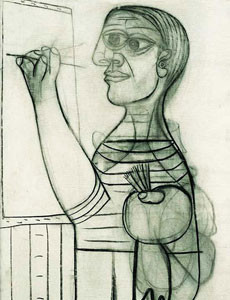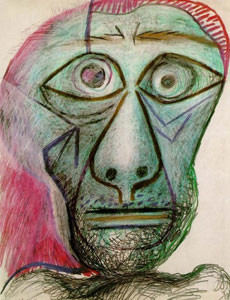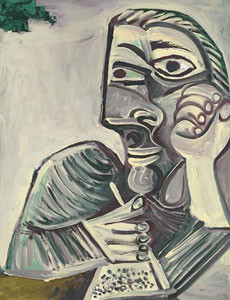English | 简体中文
Author: Annie Zhang
Thanks to: Ying, Winnie, Amy and Vincent
Date: 02/04/2017
When speaking of Pablo Picasso (1881-1973), people tend to think of distorted figures & seemingly disproportionate sculptures, as many do not understand how he became known across the world as one of the greatest artists of the 20th century. Evidently, people also question why Picasso’s art is so significant; dominating the scenes of art history and continually influencing our studies of visual arts.
He is the only artist in history to have lived to witness the exhibition of his works in the Louvre Museum.
Inside this week’s knowledge pamphlet/booklet, we are going to talk about the rising of Pablo Picasso; his tale, cross-era artistic thinking and important status in art history.
At noon, October 25, 1881, Picasso was born in the beautiful city of Malaga, located in southern Spain which lies on the coast of the Mediterranean. When he was born, he did not breathe, his family thought he was a stillborn, but the child’s uncle, El Salvador, is indeed an experienced doctor. Taking a cigar over the child’s nose and puffed cigar fog, ss if to disturb the child’s sleep. As such, by a loud cry Picasso came to the world.
Picasso had a difficult birth and was such a weak baby that when he was born, the midwife thought that he was stillborn so she left him on a table to attend his mother. It was his uncle, a doctor named Don Salvador, that saved him:
“Doctors at that time used to smoke big cigars, and my uncle was no exception. When he saw me lying there he blew smoke into my face. To this I immediately reacted with a grimace and a bellow of fury”
– Pablo Picasso
Picasso was baptised as ‘Pablo Diego José Francisco de Paula Juan Nepomuceno María de los Remedios Cipriano de la Santísima Trinidad Martyr Patricio Clito Ruíz y Picasso’. He was named after various saints and relatives. The “Picasso” from his mother, Maria Picasso y Lopez, and “Jose” from his father, Jose Ruiz Blasco.
Picasso became very fond of painting at a young age and it was like he was destined to become an artist: his first word was “piz,” short of lápiz the Spanish word for ‘pencil.’ Picasso spent the first 10 years of his childhood in Malaga, a brilliant coastal city filled with limitless inspirations for aspiring artists. And if we were to speak of coastal cities, how can one not mention the glories of contemporary Sydney with its bright sunshine, sandy beaches, blue seas, lengthy mountains and vivid light shows. Children who grow up in Sydney are truly blessed for they are accompanied with colours of ever- flourishing natural scenery.
Opposite to his Malaga home was Picasso’s childhood playground, Plaza de la Merced — an open square decorated with Phoenix trees and a sanctuary for pigeons. Picasso often played with the pigeons and naturally they became his subject of painting. The pigeons in Picasso’s paintings appeared lively and realistic and this revealed Picasso’s strong observational and shaping abilities that developed at a young age. Later, many years after the German’s Fascist occupation of France, Paris fell into darkness and Picasso painted “The Dove of Peace” to express his belief for freedom and to resonate the message of peace in a time of war. The first “Dove of Peace” was then chosen as the emblem for the First International Peace Conference in Paris in 1949 and became the one of the most influential works of his life.

There is a tragic story related to war on the embryonic form of the peace pigeon (1940), if you want to find out more, have a search online.

In order to commemorate the 2nd World Peace Conference held in Warsaw on November 1950, Picasso was honoured to draw a pigeon with an olive branch. At that time Chile’s famous poet Neruda called it “Dove of Peace” and thus, the pigeons were officially recognised as a symbol of peace.

It is important to observe the surroundings and interests of a child: what they like to watch, what they practise and what they like to invest their time into drawing over and over again (e.g. animals, characters, scenery). Because when you slowly begin to realise more and more details of their drawings and paintings, it is evidence that their observability and patience are constantly improving.
In 1890, 9 year-old Picasso completed his first painting, called “Le Picador.”


As we can see here, at the age of 16, Picasso’s work has become more mature and more sophisticated but this is not the reason that got Picasso his fame. Now let’s have a look at some self-portraits and maybe we’ll find the answer…
The dramatic changes of Picasso’s practice are made prominent to audiences when viewing his portraiture, but many will ask what is he trying to convey? His early artworks foreshadow the influence of many art styles and also reveal the development of his own artist practice. Let’s have a look at what Picasso has to say about this.
“The different styles I have been using in my art must not be seen as an evolution, or as steps towards an unknown ideal of painting…Different themes inevitably require different methods of expression. This does not imply either evolution or progress; it is a matter of following the idea one wants to express and the way in which one wants to express it.”
Picasso gradually came to understand that the essence of artistic pursuit is an instinctive expression; how to express and what ways of expression can be used to convey what the heart feels. This is why his artistic achievement is so rich and colourful. Artists who began revolutionary development of the archetypal in the early twentieth century have very remarkable achievements in painting, sculpture, printmaking and ceramics, and are considered the most creative and far-reaching artists in the contemporary world.
Picasso loves art, likes to study and think, dare to innovate. The proof of these qualities come from the following collected data on all his works.
The total number of artworks is reaches almost 37,000, and this includes 1885 paintings, 7089 sketches, 20000 prints and 6121 lithographs. Of course, the completion of all these works requires time and Picasso spent his entire life creating art and died at the age of 92.
Picasso’s works are divided into several periods,
- 1881 – 1900 Childhood
- 1900 – 1903 Blue period
- 1904 – 1906 Rose period – pink period, met his own love
- 1906-1910 African period (black period)
- 1907-1916 period of cubism
- 1917 – 1924 classical period
- 1925-1932 period of surrealism
- 1932 – 1945 period of transformation
- 1946 -1973 Pastoral period
It can be seen that every stage of life and experience will influence our emotions with subtle changes in the artworks.
In the December of 1999, he was elected as the top ten artists of the 20th century with 40% votes in a poll conducted by a French newspaper. Four of Picasso’s works take up the world’s top 10 highest auctioned paintings.
Picasso once said “Each picture is a phial with my blood. That is what has gone into it.” This memoir brings out the message of a true artist’s work: when art is produced from the heart with no consideration of rewards and benefits, but pure focus on the work itself, it will naturally reveal the artist’s thoughts.
Perhaps it was due to his precocious outlook on life and family reasons, Picasso’s earlier works were full melancholy as he often painted in an expressionist style. During school, Picasso studied the traditional art techniques which he helped him produced works like “First Communion” (1869) – depicting religious themes and symbolism.

Among art seekers, Picasso’s practice is constantly changing and transforming. From experimentation with Impressionist, Post-Impressionist and Fauvism, Picasso shows his ability to manipulate variations of artistic style whilst maintaining the works’ own rough and bold nature of expression.
In the pursuit of art, one may find many things they like on the journey and this includes various objects, scenery and forms of art style. It is important to extract inspiration from these elements to develop and create one’s own artistic expression.

A very famous painting, known as the Picasso Mona Lisa, Picasso uses a taupe tone to paint Gertrude Stein who played an important role in the Parisian artist circle of the time. From the painting can See that Picasso was deeply influenced by artworks from Africa, placing emphasis on geometric modeling, in the portrait the hand is painted realistically, however the face is painted like a African indigenous mask. At that time those who saw the painting were very surprised and commented that it did not look like Stein. In regard to the comments, Picasso replied: “One day, she will look more and more like the painting”.
Thirty years later, Stein pointed to the portrait, said to others: “Look, Picasso was right, I have gradually come to look like the portrait.” Later the “Stein portrait” became Picasso’s turning point from the “pink period” to the “Cubism” and many art critics have claimed to this picture to be Picasso’s “Mona Lisa”

This magic of the painting was that Stein aged to look more and more like her portrait. During the making of the portrait Picasso painted her over 100 times. Picasso’s devotion to the painting is shown through his portrayal of not only the individual but rather the character. I am very appreciative of Picasso’s analysis of Cubism (1910-1914). Cubism is a movement and genre in the history of Western modern art. The origin of its history began in 1908 in France when Cubist artists pursued fragmentation, parsing, reassembling forms to form separate images.

When a whole piece of glass is broken and each piece is represented as a camera, then placed to photograph various parts of a violin and grapes then finally re-combined into a painting forms the basis of cubism. Cubism represents life in its original where Picasso has extended it be expressed through a portrait. Picasso made his first collage with Braque which has also incorporated Fernand’s head as a representative of the use of cubism through portraits.

This was painting was painted by Picasso over a long period of time and was shocked by its similarity to the recipient of the Hugo Award of the science fiction novel “The Three Body Problems”, which introduces a particularly imaginative weapon which had the ability to transform three-dimensional objects to become two-dimensional. The original author of the fiction describes this weapon to have similar abilities as Dali’s paintings, and personally I believe Picasso’s paintings have presented a similar idea. The portrait of Picasso looks somewhat like a sculpture, which has been altered from three-dimensional to be two-dimensional pieces. Picasso conveys all 3d objects and character in his own unique to fit into the 2d plane, and observing his works often give the audience a feeling of being in a multidimensional world.

There is another one of Picasso’s famous paintings, “Rose,” a masterpiece often said to look like Da Vinci’s “Mona Lisa” in mysteriousness and Van Gogh’s “Gachet doctor” in melancholy aesthetic. This painting was Picasso’s “Boys holding a pipe” created at the age of 24 in 1905. It was auctioned at the price of $ 1.04 billion at the Sotheby’s auction in New York in May 2004 and established the highest record price in the world at that time.
“The senior vice president of the auction house Norman stated that the portrait contained a poetic mood which was considered to be so breathtaking it attracted all who saw it,”
During this time Picasso had just settled near Montmartre near Paris, France the young Parisian boy whom Picasso called “Little Louis”, often went to Picasso’s studio to spend time, and used him as a model for the “boy holding the pipe”. The painting of “Little Louis” pictures him in blue overalls, with his left hand holding a pipe, wearing a garland, the background for the artwork is the two bouquet of flowers which makes it look like a Chinese painting. “Little Louis” wears a wreath on his head which experts believes to have been spontaneously decided by Picasso decided upon completion however the harmonious and color seem to complement the overall painting.
In Picasso’s long creative career, he was once obsessed with sculpture art, and had experimented with a variety of techniques and materials including traditional and non-traditional ones. His sculpture has never been sold nor has he ever learnt to sculpt, however in his process of experimentation in sculpting Picasso has been able to learn new techniques and venture beyond traditional methods of sculpting. Picasso is also very fond of his own sculptures and remains in possession of the majority of them and still reluctant to share them and lives with them like family. After his death, the majority of these sculptures became part of the earliest collection of the Picasso Museum in Paris. In 1996, Picasso’s sculpture exhibition held in Paris was the first time the public witnessed his sculptures. In 2015 a sculpture exhibition in honour of Picasso was held at MoMA in New York, which was the largest in the past half century for Picasso’s sculpture collection. The scale of the public display included 140 pieces of sculpture, which ranged from pieces mad from1902 to 1964 which covered the entire creative career Picasso. Works for the exhibition arrived from the United States and overseas public institutions and private collections, including 50 works from the Paris Picasso Museum (Musée national Picasso-Paris).

The sculpture, dedicated on August 15, 1967, in Daley Plaza in the Chicago Loop, is 50 feet (15.2 m) tall and weighs 162 short tons (147 t). The Cubist sculpture by Picasso was the first such major public artwork in Downtown Chicago, and has become a well-known landmark.

Guitar; a cardboard material where Picasso in the sculpture closed space tradition incorporates a negative space. During this time period, Picasso also began to create still life sculptures, through the use of simple handicrafts, such as paper cutting, cutting, folding, weaving, etc. to system. The use of integrated materials from modern art is also derived from Picasso. Today Picasso’s use of integrated materials continues to affect the fashion industry and construction industry.

And then made with colored metal pieces and wire a three-dimensional block violin and guitar sculpture is constructed. The first display of the six shapes of the glass series also embodies the Cubist style.

Guitar, 1926 – Pablo Picasso

Pablo Picasso, Guitar, Céret, March 31, 1913, or later. Cut-and-pasted newspaper, wallpaper, paper, ink, chalk, charcoal, and pencil on colored paper, 26 1/8 x 19 1/2

Pablo Picasso, Violin Hanging on the Wall, 1913, Oil, spackle with sand, enamel, and charcoal on canvas
The combination of integrated materials give the children of today inspiration in their paper-cutting, collages, semi-painted and semi-craft artworks is their pursuit of art and education is derived from Picasso. Therefore Picasso’s works are trans-era, making him among the top 20 of the world’s greatest painters.
There is a group of artworks I must share with you.

Pablo Picasso. Bull (1945-1946). A Lithographic Progression.
Picasso said “A picture used to be a sum of additions. In my case a picture is a sum of destructions.”
We picture a child’s painting from they first hold a pen, they begin with simple lines and then slowly began to form a object or person (they only paint what they like), they then learn to slowly add the details, which is much like Picasso’s reverse derivation of the cattle process art piece.
The process from simple to complex is the process of learning, which is a process of use and requires practice, observation, research and imagination. Today’s art is not longer simply painting and behind the scenes of each painting is the need for a strong knowledge, the more we know the richer a painting is in connotation.
Previously the Starry Arts knowledge booklet discussed an abstract master Piet Mondrain who in October 1911, at nearly the age of 40, first witnessed the Picasso and Braque’s cubism work and was astounded. Soon after this he created his pure style system and became one of the founders of the style behind the scenes artists and non-figurative paintings. The keen artistic touched Piet Mondrian drew inspiration from the Cubist paintings. Nowadays, children live in the modern society filled with rapid development of science and technology, and can easily appreciate the works of outstanding artists both in ancient and modern times. In May this year, Van Gogh’s works will be exhibited in Melbourne, which is the welfare given to children in our modern society. Children no longer learn in a boring environment however are encouraged to express art in their learning. However no matter what you do it is important to put your heart to it and art is no exception, painting your personal imagination with the combination of help from the teacher will for the new generation of artists.


